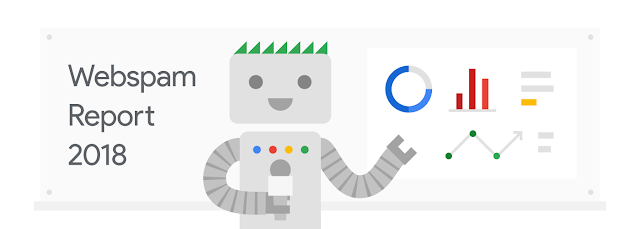Hacked spam, while still a commonly observed challenge, has been more stable compared to previous years. We continued to work on solutions to better detect and notify affected webmasters and platforms and help them recover from hacked websites.
In the last few years, we’ve observed an increase in spammy sites with auto-generated and scraped content with behaviors that annoy or harm searchers, such as fake buttons, overwhelming ads, suspicious redirects and malware. These websites are often deceptive and offer no real value to people. In 2019, we were able to reduce the impact on Search users from this type of spam by more than 60% compared to 2018.
As we improve our capability and efficiency in catching spam, we’re continuously investing in reducing broader types of harm, like scams and fraud. These sites trick people into thinking they’re visiting an official or authoritative site and in many cases, people can end up disclosing sensitive personal information, losing money, or infecting their devices with malware. We have been paying close attention to queries that are prone to scam and fraud and we’ve worked to stay ahead of spam tactics in those spaces to protect users.
Much of the work we do to fight against spam is using automated systems to detect spammy behavior, but those systems aren’t perfect and can’t catch everything. As someone who uses Search, you can also help us fight spam and other issues by reporting spam on search, phishing or malware. We received nearly 230,000 reports of search spam in 2019, and we were able to take action on 82% of those reports we processed. We appreciate all the reports you sent to us and your help in keeping search results clean!
So what do we do when we get those reports or identify that something isn’t quite right? An important part of what we do is notifying webmasters when we detect something wrong with their website. In 2019, we generated more than 90 million messages to website owners to let them know about issues, problems that may affect their site’s appearance on Search results and potential improvements that can be implemented. Of all messages, about 4.3 million were related to manual actions, resulting from violations of our Webmaster Guidelines.
And we’re always looking for ways to better help site owners. There were many initiatives in 2019 aimed at improving communications, such as the new Search Console messages, Site Kit for WordPress sites or the Auto-DNS verification in the new Search Console. We hope that these initiatives have equipped webmasters with more convenient ways to get their sites verified and will continue to be helpful. We also hope this provides quicker access to news and that webmasters will be able to fix webspam issues or hack issues more effectively and efficiently.
While we deeply focused on cleaning up spam, we also didn’t forget to keep up with the evolution of the web and rethought how we wanted to treat “nofollow” links. Originally introduced as a means to help fight comment spam and annotate sponsored links, the “nofollow” attribute has come a long way. But we’re not stopping there. We believe it’s time for it to evolve even more, just as how our spam fighting capability has evolved. We introduced two new link attributes, rel="sponsored" and rel="ugc", that provide webmasters with additional ways to identify to Google Search the nature of particular links. Along with rel="nofollow", we began treating these as hints for us to incorporate for ranking purposes. We are very excited to see that these new rel attributes were well received and adopted by webmasters around the world!
As always, we’re grateful for all the opportunities we had last year to connect with webmasters around the world, helping them improve their presence in Search and hearing feedback. We delivered more than 150 online office hours, online events and offline events in many cities across the globe to a wide range of audience including SEOs, developers, online marketers and business owners. Among those events, we have been delighted by the momentum behind our Webmaster Conferences in 35 locations across 15 countries and 12 languages around the world, including the first Product Summit version in Mountain View. While we’re not currently able to host in-person events, we look forward to more of these events and virtual touchpoints in the future.
Webmasters continued to find solutions and tips on our Webmasters Help Community with more than 30,000 threads in 2019 in more than a dozen languages. On YouTube, we launched #AskGoogleWebmasters as well as series such as SEO mythbusting to ensure that your questions get answered and your uncertainties get clarified.
We know that our journey to better web with you is ongoing and we would love to continue this with you in the year to come! Therefore, do keep in touch on Twitter, YouTube, blog, Help Community or see you in person at one of our conferences near you!






